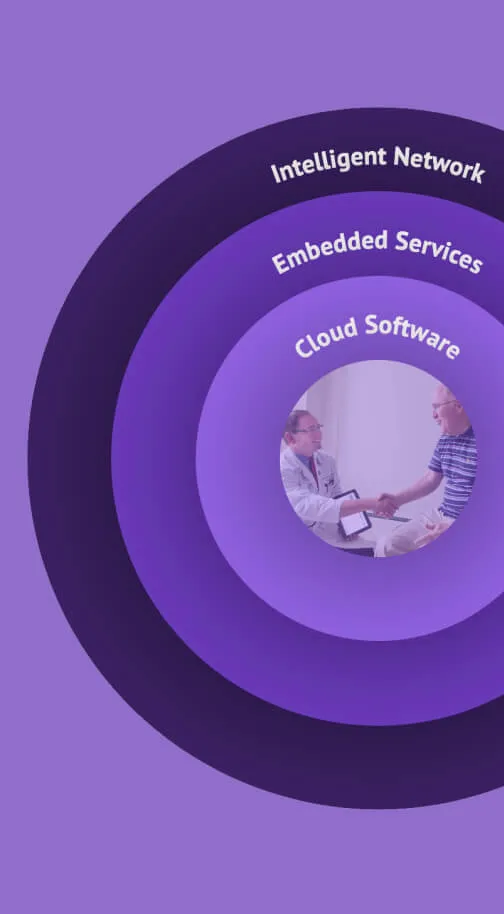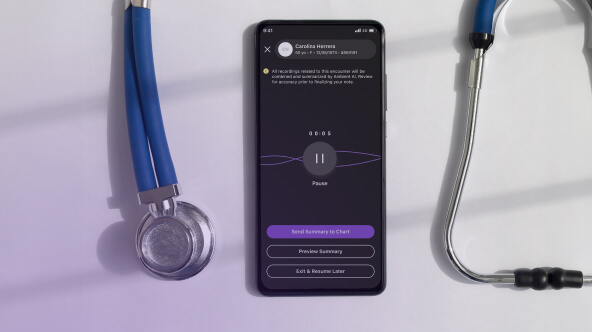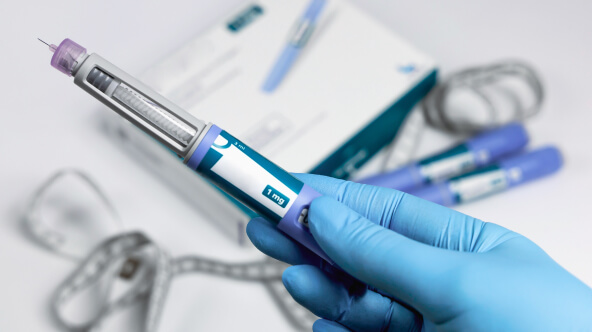Predictions for changes in value-based care, AI in healthcare, patient digital tools, and more in 2025
A new year brings new opportunities—and new challenges—to the healthcare industry. To thrive in 2025, medical practices and healthcare organizations need to know what trends and industry shifts they should expect, or risk falling behind. Staying in the know can help practices get ahead of key issues like provider burnout, administrative burden, patient attrition, failing to meet quality requirements for VBC programs, and other common challenges in the healthcare industry.
Luckily, we’re here to help you stay informed about the most critical trends and changes that we can expect to see in 2025. But before we dive in, let’s quickly recap the shifts that this past year brought to the healthcare industry.
2024 saw changes made to Medicare Advantage and Part D, the continued evolution of EHR software, new use cases for artificial intelligence (AI) in healthcare, ongoing decline in the number of healthcare workers entering the workforce, and it was also an election year.
In 2025, we can expect to see the continuation of some of these trends. It’s estimated that by next year, there will be a shortage of approximately 200-450K RNs alone, or about a 10-20% gap.1 This labor shortage puts pressure on the industry to flex to accommodate this gap, and places focus on sustainable solutions that can help medical practices do more with fewer staff and resources. As a result, we predict 2025 to be a critical year for healthcare IT (HIT), with many organizations seeking new and innovative technology that can help combat physician burnout and the rising costs of care.
To help you anticipate and navigate these crucial shifts, we’ve asked some of our in-house experts to chime in with their top predictions for the healthcare industry in 2025, helping your organization to leverage these insights and stay ahead.
Prediction 1: The continued integration of machine learning and AI in healthcare
The expansion of predictive, interpretive, and generative AI in healthcare has the power to reduce top challenges for physicians in the coming years: combat clinician burnout, streamline routine administrative tasks, keep patients connected and informed, more accurately confirm patient diagnoses, and more. Currently, about 28% of medical groups surveyed use ambient AI technology to transcribe speech or draft notes.2 Voice-powered services and predictive text have the power to transform clinical documentation in healthcare and are already being used by physicians to free up time for patient care and other urgent tasks.
AI investment in healthcare is projected to grow significantly, from about $20 billion in 2024 to $150 billion over the next five years.3 In 2025, we can expect to see the continued expansion of features like AI-supported clinical documentation and patient communication tools, as well as new, innovative uses cases aimed at saving providers time and bolstering data analytics capabilities for healthcare facilities.
Next year, we also predict discoveries of new healthcare AI use cases coming into play, with more enterprise-scale healthcare organizations investing in: AI integration for clinical decision support, machine learning to help analyze and identify patterns in large and complex sets of raw data such as imaging scans and labs4 Beyond 2025, AI in healthcare could bring enhancements to patient-provider communication using machine learning (ML) to create personalized care plans as well as personalized patient outreach and follow-up.
The biggest blocker for the integration of AI and ML in healthcare remains the issue of data privacy and security, especially with HIPAA compliance as a factor. Enterprise healthcare organizations will be hard-pressed to ensure the security of Protected Health Information (PHI) and will be incentivized to utilize their own private integrations of AI to help keep patient data safe. In addition, determining the most useful applications of AI technology, as well as tuning and monitoring it to both meet quality standards and mitigate risk, could continue to pose a challenge in the healthcare space.
athenahealth’s Senior Architect of Data Science & Platform Data Eng., Heather Lane, shares her point of view:
"We’re in a moment of dramatic change in the technology of AI. In turn, that’s producing a huge innovation push in the market, including in healthcare, trying to bring practical applications of the technology to real production. As with all moments of profound change, it’s incredibly difficult to “pick the winners" – to know which ideas will pan out and which will go into the dustbin of failed innovations.
While many ideas about the uses of AI in healthcare have been suggested, my bet is on technology that eases people's working experience. Automatic note generation is a clear current interest point, for good reason, because of its potential to dramatically improve providers’ day-to-day work. There have also been suggestions of supporting patient communication, clinical decision making, diagnosis, and documentation completion, as well as improving UI workflows in small and large ways. There are significant risks in healthcare, so I would expect product rollouts to prioritize lower-risk cases first, setting aside the higher-risk cases until the industry has developed more experience with the technology and safety controls."
Prediction 2: A steady rise in demand for popular specialties within the healthcare industry
With changes in patient needs, modes of care delivery, and the overall healthcare landscape, certain specialties will likely rise to the occasion to meet patients where they are. 2025 could see expansion in practices for currently popular—and rapidly growing—specialties like urgent care and behavioral health. Let’s take a closer look.
1) Urgent care
There are currently more than 14K urgent care centers in the U.S., and the current growth rate for new centers is 7%.5 The post-COVID endemic stage continues to reveal patient need for quicker, more convenient access to care—especially when it’s difficult to see a primary care provider (PCP) or a specialist, or when care is needed beyond typical business hours.
Urgent care has been shown to fill a gap for those seeking immediate care for injuries and common health issues that don’t require an ER visit, and those managing a chronic illness who otherwise can’t wait to be seen by their PCP or can’t be seen by a specialist due to long wait times, inadequate coverage, or other reasons. It’s estimated that urgent care centers prevent around 24.5 million ER visits annually, helping reduce burden on ER providers and saving patients valuable time and money.6 Based on current patient needs, we can predict that next year will bring a steady growth in demand for urgent care providers and facilities across the U.S.
2) Behavioral health
Recent years have seen growing political attention for mental health awareness and increased access to behavioral health treatment. What’s more, about 25%, or one quarter, of the U.S. population are predicted to utilize behavioral health services by 2027.7 Remote therapy and counseling sessions have also become more prevalent following the COVID-19 pandemic, allowing greater access to mental health care via telehealth services and virtual care.
A steadily declining stigma and an increasingly nuanced understanding of mental health conditions in the U.S. means that behavioral health practices are poised to expand in 2025 and beyond. We can expect to see a continued increase in the number of behavioral healthcare practices, as well as many existing mental health practices integrating new HIT tools and EHR software to help physicians better manage their growing patient rosters.
Prediction 3: Increased adoption of value-based care to diversify payment models
Despite recent upheaval in the Medicare marketplace caused by changes to the way Medicare awards star ratings8, we believe that all provider organizations should be prepared to take on more risk for both cost and quality in 2025.
Medicare Advantage enrollment is expected to slightly increase in 2025, to approximately 35.7 million.9 What’s more, McKinsey & Co. estimates that 90 million lives will be in value-based care (VBC) models by 2027, up 109% from 2022.10 Research also shows that 47% of physicians at healthcare organizations that incorporate a mix of payment models feel that their organization is financially secure.11
Based on this data, we can expect to see a growth in the adoption of value-based care models such as fee-for-value, shared risk, and global capitation. In 2025, medical practices will likely continue to expand and adopt VBC and alternative payment models to help incorporate new forms of payment and reimbursement and improve financial security in the coming years.
Strong connections between internal and external care providers are integral to success in VBC. We expect that this expansion of value-based care and alternative payment models in 2025 will drive a growing need for interoperability and connectivity between EMRs and HIT systems. Providers will need a more holistic, comprehensive view of patient data and overall health in order to create wellness plans that drive long-lasting improvements and meet quality program requirements. As is the case for many healthcare organizations using or adopting VBC payment models, the quality of data will continue to be more critical than quantity.
Research also suggests that successful providers following a VBC model will need to focus on things like improving risk-coding accuracy and improve adherence of referrals to high-quality providers in the immediate future, while things like predicting healthcare risk status and remote patient-monitoring will be more difficult challenges to tackle in the years to come.12
"For physician practices, the biggest challenge in the growth of value-based reimbursements is how to be flexible enough to participate in multiple payment models (the world isn’t going all in on one model anytime soon) without being overwhelmed by the complexity of all those models. Smaller practices will need partners to help them build the right capabilities and get a scale advantage. Larger groups will need to better understand the total cost of that complexity and partner with organizations that can help them across the breadth of contract types that they have."
Prediction 4: Increased demand for digital tools like patient portals
Patient need for digital healthcare tools, patient portals, and self-serve features is strong. Over 75% of patients surveyed think that digital tools improve their experience with the healthcare system.13 These are strong signals that patients find value in the ability to quickly message their provider or self-schedule their next appointment. What’s more, patient digital engagement benefits both the patient and the provider, helping with stronger communication, more comprehensive patient care, increased patient payments, and reduced administrative work.
But not all digital tools will get the same share of the limelight in 2025. Compared to a meteoric rise during the pandemic, we predict that telehealth utilization will continue to expand next year, but mostly within certain specialties such as women’s health and behavioral health where digital engagement remains high.
Recent data shows that providers with higher rates of patient digital engagement have a corresponding increase in patient pay yield (PPY), faster encounter closure, and shorter charge entry lags.14 This means that healthcare organizations that effectively engage patients via digital tools and patient portals can have increased financial performance compared to those who don’t. This incentivizes medical practices to invest in expanding access to digital patient tools and more robust patient self-serve technology in 2025 to help them to reap the rewards in the years ahead.
Finally, with patient engagement metrics and patient-provider communication playing such a critical role in success within value-based care programs, we can expect to see a growing demand for innovative, convenient, and user-friendly patient digital tools in 2025 and beyond.
As your healthcare organization looks ahead to the new year, these trends and insights can be a tool to help you cut through the noise and get actionable advice to stay ahead of industry changes. Practices that lean into incorporating new VBC payment models, new HIT software and tools, and new modes of patient-provider communication in 2025 could yield some incredible results—and these data-backed predictions serve to help your organization grow, thrive, and continue delivering the best quality of care. Navigating the healthcare landscape is never easy, but your organization can lean on the experts to help you succeed.
- McKinsey & Co, “Assessing the lingering impact of COVID-19 on the nursing workforce”, May 2022, https://www.mckinsey.com/industries/healthcare/our-insights/assessing-the-lingering-impact-of-covid-19-on-the-nursing-workforce
- MGMA Stat Poll, May 2024, Ambient technology’s role in the ongoing AI revolution in healthcare
https://www.mgma.com/mgma-stat/ambient-technologys-role-in-the-ai-revolution; IS157 - MGMA, “Ambient technology’s role in the ongoing AI revolution in healthcare”, May 2024, https://www.mgma.com/mgma-stat/ambient-technologys-role-in-the-ai-revolution
- NIH, “Machine Learning in Healthcare”, Dec 2021, https://pmc.ncbi.nlm.nih.gov/articles/PMC8822225/
- Urgent Care Association, Aug. 2023, Urgent Care Industry White Paper: The Essential Nature of Urgent Care in the Healthcare Ecosystem Post-COVID-19, Aug. 2023, pg 3,
https://urgentcareassociation.org/wp-content/uploads/2023-Urgent-Care-Industry-White-Paper.pdf; IS089 - Urgent Care Association (UCA), “The Essential Nature of Urgent Care in the Healthcare Ecosystem Post-COVID-19", Aug 2023, https://urgentcareassociation.org/wp-content/uploads/2023-Urgent-Care-Industry-White-Paper.pdf
- Trilliant Health, Sep. 2023, 2023 Trends shaping the Healthcare Economy, Pg 50
https://www.trillianthealth.com/hubfs/TH_Annual%20Report_2023.10.25%20(2).pdf?hsCtaTracking=5d012254-6902-4aa3-9ff8-a01abc8d5738%7Cab894e50-dd03-428f-84b2-27361c687a84; IS143 - CMS, “2024 Medicare Advantage and Part D Star Ratings”, Oct 2023, https://www.cms.gov/newsroom/fact-sheets/2024-medicare-advantage-and-part-d-star-ratings
- CMS, “Medicare Advantage and Medicare Prescription Drug Programs to Remain Stable as CMS Implements Improvements to the Programs in 2025”, Sep 2024, https://www.cms.gov/newsroom/fact-sheets/medicare-advantage-and-medicare-prescription-drug-programs-remain-stable-cms-implements-improvements#:~:text=Average%20Medicare%20Advantage%20premiums%20are,stay%20in%20their%20current%20plans.
- McKinsey & Company, Jan 2024, What to expect in US healthcare in 2024 and beyond, https://www.mckinsey.com/industries/healthcare/our-insights/what-to-expect-in-us-healthcare-in-2024-and-beyond?stcr=FEFACC03D40F492EBD8401B5DCEEB6C3&cid=other-eml-alt-mip-mck&hlkid=2d8461c861f644cdb13cae55b6af9283&hctky=14669808&hdpid=edd3998f-a0c6-45fa-86c6-b0cd71574e4d; IS079
- 2023 Physician Sentiment Survey, commissioned by athenahealth and fielded by Harris Poll, Jan 2024
- McKinsey & Co. “Investing in the new era of value-based care”, Dec 2022, https://www.mckinsey.com/industries/healthcare/our-insights/investing-in-the-new-era-of-value-based-care
- athenahealth, “Patient Digital Engagement Index (PDEI) Research Report”, October 2024
- athenahealth, “Patient Digital Engagement Index (PDEI) Research Report”, October 2024













